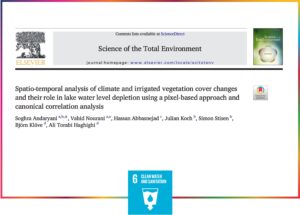
A collaborative study, including a researcher Nourani from Near East University, investigated the factors contributing to the decline of Lake Urmia, one of the world’s largest hypersaline lakes. The study utilized a pixel-based analysis (PBA) approach to assess trends in climatic and anthropogenic factors, such as temperature (TEMP), precipitation (PCP), snow cover, and irrigated vegetation cover (IVC), and their impact on Lake Urmia’s water level (LWL).
By applying a non-parametric Mann-Kendall trend test to satellite data spanning from 2000 to 2020, the study revealed significant increases in temperature during May to September, with temperature rising by 1 to 2 °C across 87% to 25% of the basin. However, precipitation exhibited an insignificant decrease during rainy months, while snow cover declined, indicating a shift from snow to rain.
Notably, the analysis showed a significant increase in IVC across all sub-basins, particularly in the southern parts of the lake, with the West province making the largest contribution. The study highlighted the substantial role of IVC in the decline of Lake Urmia, along with the influence of climate change.
Conclusions drawn from the study underscored the importance of PBA in identifying spatial and temporal changes in environmental variables, providing valuable insights for regional planning and management. Additionally, the study emphasized the need for sustainable development practices, including land use management and water resource conservation, to mitigate the adverse effects of climate change and anthropogenic activities on Lake Urmia.
Furthermore, the study recommended localized adaptation measures, such as adopting climate-smart agricultural practices and optimizing water usage in irrigation, to alleviate the pressure on Lake Urmia’s water resources. By implementing these measures, the study suggested that it would be possible to mitigate the depletion of Lake Urmia and promote its ecological restoration.
Overall, the findings of this study align with previous research on the subject, highlighting the urgent need for concerted efforts to address the challenges facing Lake Urmia. By combining scientific analysis with targeted interventions, stakeholders can work towards preserving this vital ecosystem for future generations.
More Information:
https://www.sciencedirect.com/science/article/pii/S0048969723009427